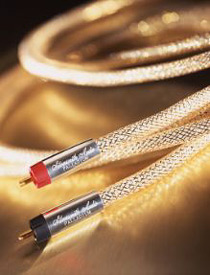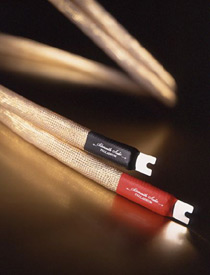 |
|
| November 1, 2002 Silversmith Audio Palladium Interconnects and Speaker Cables
Nature abhors a vacuum, and so do audiophiles. I think I speak for our enchanted gulag in declaring a preference for breathing, despite an acquaintance having suggested oxygen-free rooms as a complement to oxygen-free copper. Interesting, but no: The respirator’s noise would more than cancel whatever benefits a gas’s banishment held. Speaking of benefits -- my wife and I moved some while ago from particulate-choked Megalopolis to a little coastal town awash in fresh air. We occupy a 154-year-old house, the front parlor of which (my listening room) approximates paradise. Before we took occupancy, I had our electrician install discrete hospital-grade outlets for the audio system. Compared to our former digs, the noise floor is in the cellar. (Out in the boonies it’s at bedrock, but in-town living was milady’s condition, and I’m not regretting it. Our daily strolls to the harbor restore the soul.) This is certainly the best place in my experience for judging cables. As another means of clearing the air, there has been a significant addition to my system: Combak Harmonix’s Reimyo ALS-777 line conditioner, about which I’ve reported here. If you’re as hard-bitten as I am, you’ll understand my remarking that, having lived with it, I cannot do without it. On, then, to Silversmith: The speaker cables of both the Silver and Palladium lines are fashioned like no other. Envision a .75"-wide strip of foil. Notch it at both ends. These are your spade lugs. I’m putting you on? Go to www.silversmithaudio.com for pictured proof. Jeff Smith judges conventional terminations as sources of sonic degradation. Further, in order to approach an air dielectric (air being a conductor’s least interactive garment), the foil floats within an oval Teflon sheath covered, in turn, by a polyethylene-Mylar mesh. Silversmith’s interconnects are as supple as string. The featherweight speaker cables flex up and down with ease, but not from side to side. This could make the marriage of those notched foil ends to your binding posts something less than a stroll down the aisle. My setup is unusual in that it stresses short cable runs. With my mono amps just behind and to the inside of the speakers, the Palladiums’ foil terminations double back on themselves at the speaker end. My amplifiers’ protruding heatsinks render the foil’s access to the output posts likewise challenging. There are two speaker cables per side. In order to prevent the ribbons from touching, one is obliged to position their notched ends into the speakers’ close-set binding posts close to horizontal from the outside in rather than vertically. In the event, the review Palladiums swoop up and around, descending on my amps from above. Unattractive, no; unconventional, yes. With regard to rips at the notched ends, the palladium foil is tougher than it looks. I’ve had no difficulty installing this 6' pair (in an application where I normally prefer four-footers). If you’re the sort who fusses over cables -- reviewers must -- be aware of the risk, particularly if, as an economy, you opt for the shortest possible length. These are expensive playthings. The metal is right up there with the planet’s costliest. As to that, Smith’s website has this to say: "Our . . . palladium alloy conductor does not oxidize and improves upon the skin-effect related characteristics of gold, silver, copper, and aluminum by up to 25-fold." In certain circles, audiophile cables are controversial still. Some flaps never subside. We’re told that for mere mortals a transmission wire’s skin effects are inaudible. While I am disqualified to rebut or even comment, I can certainly report on what I hear. As a reality check, from time to time I replace audiophile wires with nondescript equivalents and come away convinced that the naysayers have it wrong. Differences among cables are audible, particularly when comparing the upmarket range with the low. Run-of-the-mill cabling degrades sound, though I’d be foolish to suggest that no bargain exceptions exist. Suffice that the present report deals with what I understand to be la crème de la crème. Suffice also that Smith’s claim for the Palladium line’s superiority over his own Silvers seems to me valid. A triumph, in effect, over "skin-effect related characteristics"? A great number of things are possible. I’m inclined to take Mr. Smith at his word. As to the system within which the Palladiums operate, Wilson WATT/Puppy 6es sit 7.5' apart on center and 9.5' from the sweet spot in a 15' x 15' room, exclusive of a 9' x 4' bay. A large carpet, two couches, and an armchair, along with a motley of related furnishings, provide plenty of deflective and absorptive surface to blunt acoustic anomalies. The amps are Mark Levinson No.33H monoblocks. As my Mark Levinson No.390S CD player (upgraded from a No.39) has its own good level control and CDs are all I play, I don’t require a preamp. Silent Running Audio acoustic isolation platforms support the three ML pieces. Power cords are Acoustic Zen Gargantua. My reference cabling is Nordost’s Valhalla. (Madrigal Audio, the manufacturer of the Mark Levinson line, sponsors my online music review, La Folia.) Now to the Palladiums, from the outside in. The glittery-gold outer mesh puts me in mind of girls at the prom dancing with boys in powder-blue tuxes and frilly-front shirts. Less flamboyance, maestro, please! But oh, the sound! With both the Palladium balanced interconnects and speaker cables in place, the word is ravishing. As with all great audio, the magic’s in the midrange. Unusually warm? Not so’s you’d notice. Liquid? A curious term. I envision plastic drop cloths under the speakers. I can best characterize the Palladium experience in the subtractive: grainless. Another curious term, I suppose, and probably off the mark with respect to what’s actually happening to make these cables sound as good as they do. Or as invisible. Is it absurd to suggest that thousands of dollars buy absence? Not if you’ve been at this game for a while. The Palladiums’ midrange purity compares with the view milady and I have of the islands several miles beyond our harbor. On a good day, we see the trees. The smudge blanketing urban vistas simply isn’t there. (Should one ever appear -- an urban vista, I mean -- I go on the wagon.) Great audio gets us closer to the recording, inasmuch as a great midrange gets us closer to the true sound of unamplified voices and musical instruments. I’ve had cables in my system -- good cables -- that do lovely things to the midrange, but at the price of impaired resolution. It’s the rare cable that gets it all right. The Palladiums are remarkable in that they resolve as beautifully as anything I’ve heard. That’s a knockout combination, that is: a delectable midrange with space and air to spare. What more can one ask? Sweet and natural highs? An accurate low end? They’re there too. Smith is onto something significant. The only drawback I see -- I hear none whatever -- resides in the potential difficulties attending the speaker cable’s physical peculiarities. If you’re casting about for an upgrade and can afford the Palladiums, you owe it to yourself to give them a shot. Silversmith Audio’s website includes details of a money-back guarantee. ...Mike Silverton Palladium speaker cables (6' pair), Palladium balanced
interconnects (4.5' pair) Silversmith Audio E-mail: info@silversmithaudio.com
Ultra Audio is part of the SoundStage! Network. |

